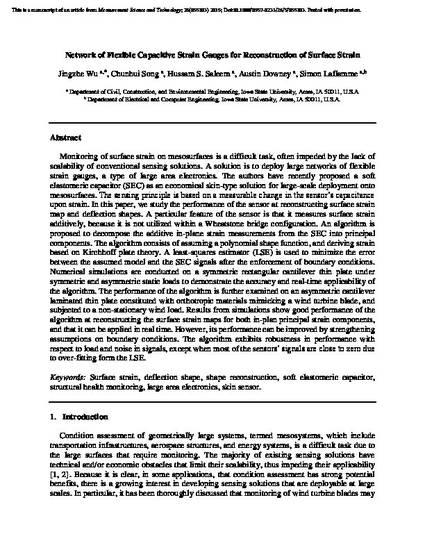
Monitoring of surface strain on mesosurfaces is a difficult task, often impeded by the lack of scalability of conventional sensing systems. A solution is to deploy large networks of flexible strain gauges, a type of large area electronics. The authors have recently proposed a soft elastomeric capacitor (SEC) as an economical skin-type solution for large-scale deployment onto mesosurfaces. The sensing principle is based on a measurable change in the sensor's capacitance upon strain. In this paper, we study the performance of the sensor at reconstructing surface strain map and deflection shapes. A particular feature of the sensor is that it measures surface strain additively, because it is not utilized within a Wheatstone bridge configuration. An algorithm is proposed to decompose the additive in-plane strain measurements from the SEC into principal components. The algorithm consists of assuming a polynomial shape function, and deriving the strain based on Kirchhoff plate theory. A least-squares estimator (LSE) is used to minimize the error between the assumed model and the SEC signals after the enforcement of boundary conditions. Numerical simulations are conducted on a symmetric rectangular cantilever thin plate under symmetric and asymmetric static loads to demonstrate the accuracy and real-time applicability of the algorithm. The performance of the algorithm is further examined on an asymmetric cantilever laminated thin plate constituted with orthotropic materials mimicking a wind turbine blade, and subjected to a non-stationary wind load. Results from simulations show good performance of the algorithm at reconstructing the surface strain maps for both in-plane principal strain components, and that it can be applied in real time. However, its performance can be improved by strengthening assumptions on boundary conditions. The algorithm exhibits robustness in performance with respect to load and noise in signals, except when most of the sensors' signals are close to zero due to over-fitting form the LSE.
Available at: http://works.bepress.com/simon_laflamme/28/

This is a manuscript of an article from Measurement Science and Technology; 26(055103) 2015; Doi:10.1088/0957-0233/26/5/055103. Posted with permission